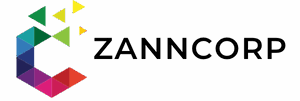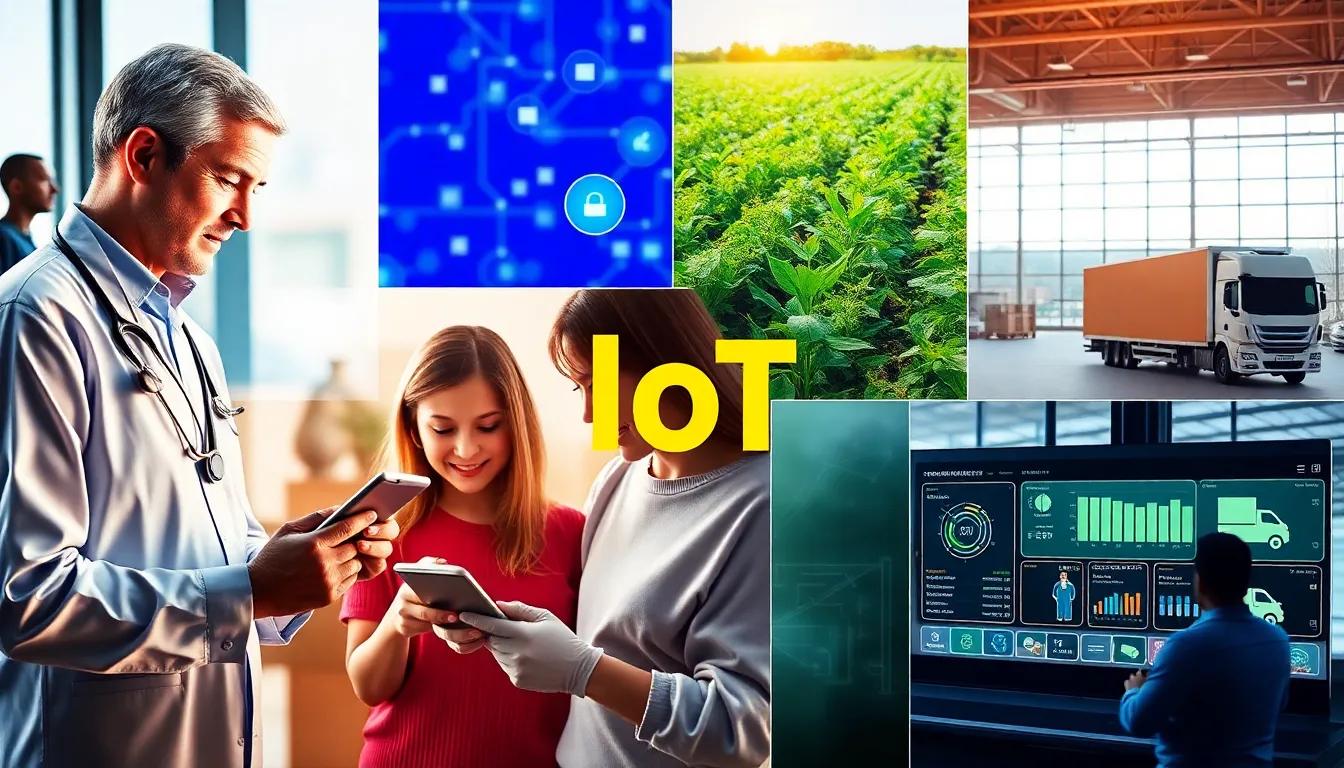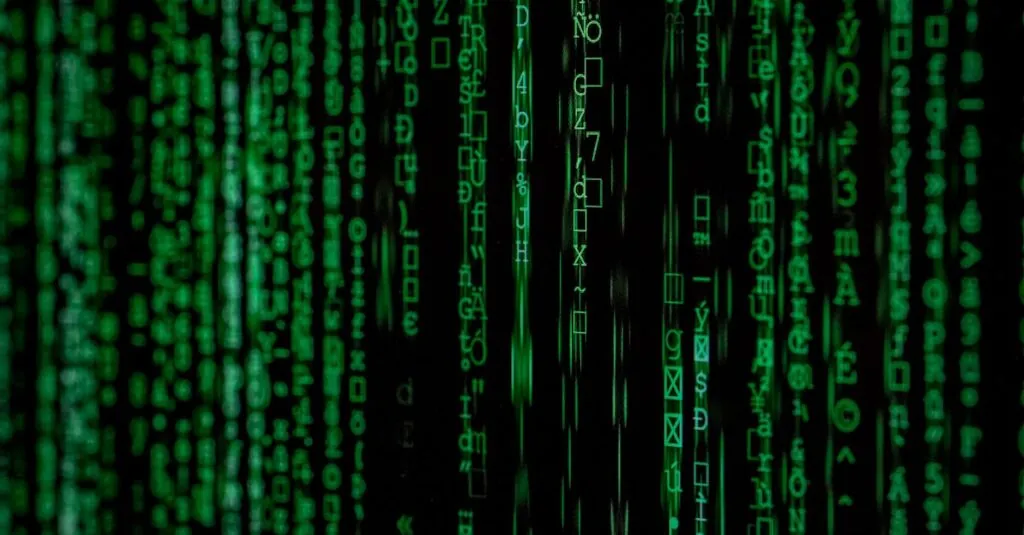Table of Contents
ToggleImagine a world where your toaster knows just how brown you like your bagel and your fridge reminds you when you’re running low on milk. Welcome to the fascinating realm of Internet of Things (IoT) applications, where everyday objects are getting smarter and more connected. From homes that adjust the thermostat while you’re still in bed to cities that monitor traffic in real-time, IoT is transforming the mundane into the extraordinary.
Overview of IoT Applications
IoT applications span various sectors, demonstrating the technology’s versatility. In smart homes, devices offer seamless integration and automation. Thermostats adjust temperatures based on preferences, while security cameras enhance home monitoring.
Healthcare benefits significantly from IoT, using wearables for real-time monitoring. Patients track vital signs, alerting healthcare providers when necessary. Smart medical devices also streamline patient care and data collection.
Industries leverage IoT for enhanced efficiency in operations. Manufacturing plants utilize connected machinery to monitor performance and reduce downtime. Supply chains gain visibility through smart sensors, improving inventory management and logistics.
Smart cities emerge with IoT-driven solutions targeting urban challenges. Traffic management systems provide real-time data to optimize traffic flow. Public safety improves as connected emergency response systems enhance coordination and resource allocation.
Agriculture sees innovative applications through IoT technology. Farmers use soil moisture sensors to conserve water while increasing crop yields. Drones equipped with sensors monitor field conditions, allowing for precise interventions.
Transportation experiences transformation with IoT applications focused on logistics. Fleet management systems track vehicles, improving route efficiency and reducing costs. Connected vehicles enhance the driving experience, providing real-time traffic updates and predictive maintenance alerts.
Energy management also evolves with smart grids and metering systems. Consumers monitor energy usage, enabling cost-effective choices. Utilities optimize energy distribution through real-time data analysis.
Environmental monitoring benefits from IoT applications. Sensors detect air quality and pollution levels, offering insights for better regulations. Climate research gains accuracy through data collected from IoT-enabled devices.
These various applications illustrate how IoT continues to bridge the gap between technology and everyday life, transforming multiple sectors for enhanced efficiency and improved experiences.
Key Industries Utilizing IoT Applications
Numerous industries adopt IoT applications to improve efficiency and enhance user experiences. This technology has made significant impacts across various sectors.
Healthcare
Healthcare leverages IoT technology to enhance patient care and monitoring. Wearable devices allow for continuous health tracking, alerting medical professionals to abnormalities in real-time. Remote monitoring systems enable patients to receive care from home, significantly reducing hospital visits. Data collected from IoT devices offers invaluable insights into patients’ health trends, contributing to personalized treatment plans. Telemedicine solutions provide convenient access to healthcare professionals, ensuring timely consultations. Hospitals increasingly integrate IoT-enabled equipment, allowing for better asset management and operational efficiencies.
Agriculture
Agriculture utilizes IoT applications to optimize crop management and resource allocation. Smart sensors monitor soil conditions, providing farmers with data on moisture levels and nutrient content. Drones equipped with imaging technology assist in surveying fields for precise interventions. Livestock tracking systems enhance animal welfare by monitoring health metrics and location in real-time. Automated irrigation systems enable precise water usage, reducing waste and improving crop yield. These applications contribute to sustainable farming practices, allowing farmers to make informed decisions and enhance productivity.
Smart Homes
Smart homes incorporate IoT technology to create convenient and secure living environments. Devices communicate seamlessly, allowing homeowners to control lighting, temperature, and security systems remotely. Smart thermostats adjust heating and cooling based on user preferences, optimizing energy consumption. Security systems, equipped with cameras and sensors, provide real-time monitoring and alerts to ensure safety. Home appliances, like refrigerators and washing machines, connect to the internet for automation and efficiency. These integrated solutions enhance daily living, making homes more responsive to individual needs.
Transportation
Transportation sectors adopt IoT applications to improve safety and efficiency. Fleet management systems provide real-time tracking of vehicles, optimizing routes and reducing fuel consumption. Connected vehicles communicate with traffic signals and infrastructure, improving traffic flow and reducing congestion. Sensors monitor vehicle performance, alerting drivers to maintenance needs before issues arise. Smart parking solutions direct drivers to available spots, minimizing search time. These innovations streamline operations, enhance safety, and offer a more efficient transportation experience.
Benefits of IoT Applications
IoT applications provide significant advantages across various sectors, enhancing operational capabilities and user experiences.
Improved Efficiency
IoT solutions streamline processes and boost productivity. Devices communicate in real-time, allowing for automated adjustments in manufacturing or smart home settings. Connected machinery operates more effectively, minimizing downtime through predictive maintenance. Smart sensors optimize resource allocation in agriculture, enabling precise water and nutrient usage. Businesses can monitor inventory levels effortlessly, decreasing excess stock or shortages. Transportation industries benefit from real-time traffic updates, which enhance route planning and save fuel costs. Increased efficiency translates into cost savings and improved service delivery across the board.
Enhanced Data Collection
IoT applications facilitate comprehensive data collection. Smart devices capture data continuously, providing insights into user behavior and operational metrics. Healthcare wearables track vital signs, delivering valuable information to providers for better patient management. In agriculture, sensors collect soil and weather data, enabling farmers to make informed decisions. Smart home systems gather usage patterns, allowing homeowners to optimize energy consumption. Connected vehicles exchange data with infrastructure, enhancing safety and navigation services. Enhanced data collection transforms decision-making processes, leading to improved outcomes in various fields.
Challenges in Implementing IoT Applications
Implementing IoT applications presents various challenges that organizations must navigate to achieve successful integration.
Security Concerns
Security concerns rank among the top challenges in IoT. Each connected device can serve as a potential entry point for cyberattacks, risking sensitive data breaches. Hackers often target weak security protocols, compromising entire networks. Users face risks, such as unauthorized access to personal information through smart home devices. Organizations must prioritize robust security measures, including encryption and regular software updates, to combat these threats. Compliance with regulations further complicates security strategies, requiring adherence to strict data protection standards.
Interoperability Issues
Interoperability issues also pose significant obstacles. Many IoT devices come from different manufacturers, leading to compatibility challenges. Variations in communication protocols may hinder seamless integration across different platforms. Users may experience frustration when devices fail to communicate effectively with one another. Standardization is critical to overcoming these issues, allowing devices to work harmoniously. Organizations benefit from developing solutions that embrace compatibility, ensuring a smoother IoT ecosystem. Stakeholders should also promote industry cooperation to establish common standards for enhanced interoperability.
Future Trends in IoT Applications
Emerging technologies shape the future of IoT applications across various sectors. Advanced AI integration in IoT systems creates smarter devices that learn user preferences, enhancing personalization. Increased adoption of 5G networks ensures faster data transmission, which leads to improved real-time capabilities in applications like smart cities and autonomous vehicles.
Significant growth in edge computing processes IoT data closer to the source, reducing latency and enhancing performance. Industries benefit from this shift, with manufacturing seeing real-time analytics that optimize production lines. Enhanced security measures are driving innovation, as organizations invest in advanced encryption methods to safeguard user data.
As sustainability becomes a priority, IoT applications focus on energy efficiency in sectors like agriculture and smart homes. Smart irrigation systems help conserve water while maximizing crop yield, reflecting a commitment to sustainable practices. In urban environments, smart grids allow efficient energy management, enabling consumers to monitor and control usage effectively.
Healthcare continues adapting to IoT advancements with telehealth solutions gaining traction. Remote monitoring devices allow physicians to track patient health data, making care more proactive. Over time, these innovations reduce hospital visits significantly and enhance patient engagement.
Smart transportation systems also evolve, focusing on connected vehicles that provide safety updates and navigation assistance. Fleet management applications utilize real-time data to optimize routes, improving delivery efficiency. Intelligent parking solutions reduce congestion, enhancing urban mobility even further.
The increasing emphasis on interoperability in IoT ecosystems supports seamless integration among devices. Collaborative efforts among stakeholders promote common standards, fostering compatibility across various manufacturers. As these trends unfold, they highlight the transformative potential of IoT applications in enhancing efficiency and user experiences.
Conclusion
The Internet of Things is undeniably reshaping how individuals and industries operate. By enhancing convenience and efficiency across various sectors IoT applications are paving the way for smarter living and working environments. As technology continues to evolve the integration of advanced AI and 5G networks will further amplify these benefits.
However the journey towards a fully interconnected world isn’t without its challenges. Organizations must remain vigilant about security and interoperability to ensure a seamless experience for users. By fostering collaboration among stakeholders and prioritizing robust security measures the potential of IoT can be fully realized.
As the landscape of IoT continues to expand its impact on daily life and industry will only grow more profound making it an exciting space to watch.





